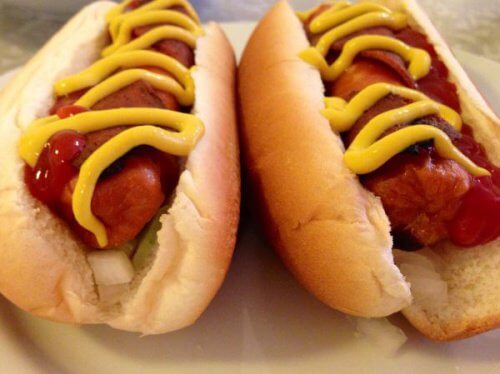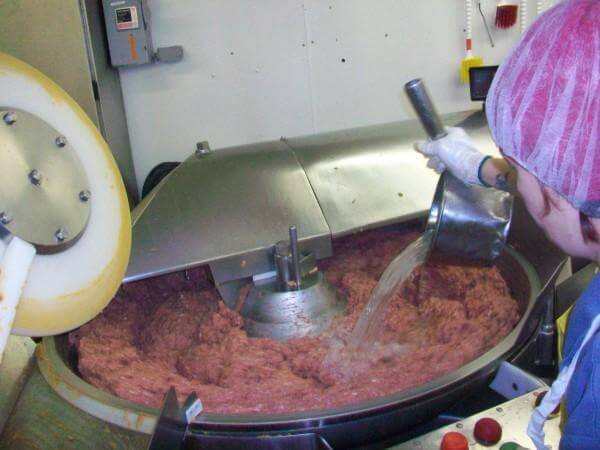Don't Feed Your Kids Hot Dogs

Hot dogs are a popular type of fast food around the world, especially in the United States. We can’t deny that we’ve all been tempted by their delicious taste at some point in our lives. Despite their delicious taste convenience, hot dogs can be really harmful to your health because they contain chemical additives in the processed meat, toppings and bun. It could be especially bad to feed your kids hot dogs.
The fact of the matter is that hot dogs have become a favorite food among children. The food industry knows that children are weak when it comes to choosing what they eat.
Regardless of the damage it may cause them in the long run, companies promote this food to make it almost irresistible to young ones. We’ll argue why you shouldn’t feed your kids hot dogs in this article.
While it’s true that eating a hot dog every once in a while won’t do major damage to the body, what worries experts is that more and more people are frequently including them in their diets, especially children.
Why is it wrong to feed your kids hot dogs?

Also Read: Things that Happen When You Quit Sugar
In an article published in the Los Angeles Times, an epidemiologist from the University of Southern California revealed that children who eat more than 12 hot dogs a month are 9 times more likely to develop leukemia.
In his article, he also cited other studies that found that children whose parents ate a diet that included hot dogs before they were born as well as those whose mothers ate a hot dog a week during pregnancy were at a higher risk for developing brain tumors.
Why are hot dogs so bad for you?
On top of the aforementioned substances found in this food, studies have found that hot dogs contain a significant quantity of nitrites, which are used to preserve foods and keep them looking fresh.
When hot dogs are cooked, the nitrites combine with the amine found in meat to form carcinogenic N-nitrous compounds. These compounds have been a subject of study and have been linked to a greater risk of liver, stomach, brain and esophageal cancers.
See Also: Quit Eating Foods that Cause Cancer
In children, experts have linked this substance to a greater risk of childhood leukemia and brain tumors.
What other foods contain nitrites?

Vegetables, especially leafy greens, also contain nitrites in small amounts. However, this case is completely different, as these types of foods reduce your risk of developing cancer.
Why? It may seem contradictory at first, but the nitrites in these foods are not harmful because they don’t combine with amine to form the same N-nitrous compounds that are found in hot dogs.
Vegetable nitrites are reinforced with vitamins D and C, which inhibit the formation of the harmful N-nitrous compounds. Vegetables are healthy, safe and great for any diet.
On the other hand, remember that all processed meats contains carcinogenic nitrites, including some types of fish, hamburger, and bacon.
What can you do about it?
- Not all hot dogs and sausages contain N-nitrous compounds. In fact, there are many different types of hot dogs and sausages on the market today that don’t contain these compounds. You can consume these with more confidence. To distinguish between the hot dogs you can eat and the ones that contain harmful compounds, remember that the ones that contain nitrites often have an attractive reddish color to make them look fresher. The ones that are safe to eat are often paler and less attractive. Nevertheless, it’s best to feed your kids hot dogs of this type.
- Eat less hot dogs, especially if your children are going to eat with you.
- Don’t eat hot dogs as a regular part of your diet. You should only eat them occasionally and preferably in small portions.
All cited sources were thoroughly reviewed by our team to ensure their quality, reliability, currency, and validity. The bibliography of this article was considered reliable and of academic or scientific accuracy.
- Bouvard, V., Loomis, D., Guyton, K. Z., Grosse, Y., Ghissassi, F. E., Benbrahim-Tallaa, L. et al. (2015). Carcinogenicity of consumption of red and processed meat. The Lancet Oncology, 16(16), 1599–1600. https://doi.org/10.1016/s1470-2045(15)00444-1
- Bryan, N. S., Alexander, D. D., Coughlin, J. R., Milkowski, A. L., & Boffetta, P. (2012). Ingested nitrate and nitrite and stomach cancer risk: An updated review. Food and Chemical Toxicology, 50(10), 3646–3665. https://doi.org/10.1016/j.fct.2012.07.062
- Cascella, M., Bimonte, S., Barbieri, A., Del Vecchio, V., Caliendo, D., Schiavone, V. et al. (2018). Dissecting the mechanisms and molecules underlying the potential carcinogenicity of red and processed meat in colorectal cancer (CRC): an overview on the current state of knowledge. Infectious Agents and Cancer, 13(3). https://doi.org/10.1186/s13027-018-0174-9
- Crippa, A., Larsson, S. C., Discacciati, A., Wolk, A., & Orsini, N. (2018). Red and processed meat consumption and risk of bladder cancer: a dose-response meta-analysis of epidemiological studies. European journal of nutrition, 57(2), 689–701. https://doi.org/10.1007/s00394-016-1356-0
- Islam, Z., Akter, S., Kashino, I., Mizoue, T., Sawada, N. et al. (2019). Meat subtypes and colorectal cancer risk: A pooled analysis of 6 cohort studies in Japan. Cancer Science, 110(11), 3603–3614. https://doi.org/10.1111/cas.14188
- Kim, S. R., Kim, K., Lee, S. A., Kwon, S. O., Lee, J. K., Keum, N., & Park, S. M. (2019). Effect of Red, Processed, and White Meat Consumption on the Risk of Gastric Cancer: An Overall and Dose–Response Meta-Analysis. Nutrients, 11(4), 826. https://doi.org/10.3390/nu11040826
- Pidugu, L. S., Maity, K., Ramaswamy, K., Surolia, N., & Suguna, K. (2009). Analysis of proteins with the “hot dog” fold: Prediction of function and identification of catalytic residues of hypothetical proteins. BMC Structural Biology, 9(1), 37. https://doi.org/10.1186/1472-6807-9-37
- Zhou, L., Anwar, M. M., Zahid, M., Shostrom, V., & Mirvish, S. S. (2014). Urinary Excretion of N-Nitroso Compounds in Rats Fed Sodium Nitrite and/or Hot Dogs. Chemical Research in Toxicology, 27(10), 1669–1674. https://doi.org/10.1021/tx5000188
- Zhou, L., Zahid, M., Anwar, M. M., Pennington, K. L., Cohen, S. M., Wisecarver, J. L. et al. (2015). Suggestive evidence for the induction of colonic aberrant crypts in mice fed sodium nitrite. Nutrition and Cancer, 68(1), 105–112. https://doi.org/10.1080/01635581.2016.1102298
- Zhu, H., Yang, X., Zhang, C., Zhu, C., Tao, G., Zhao, L. et al. (2013). Red and processed meat intake is associated with higher gastric cancer risk: a meta-analysis of epidemiological observational studies. PloS one, 8(8), e70955. https://doi.org/10.1371/journal.pone.0070955
This text is provided for informational purposes only and does not replace consultation with a professional. If in doubt, consult your specialist.








